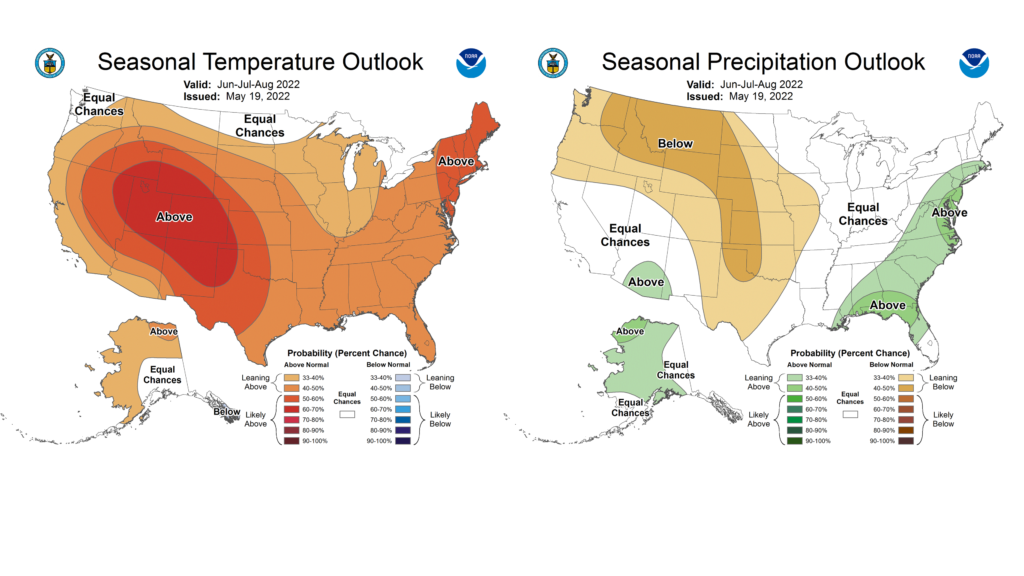The preliminary statewide average May temperature was 64.7 degrees, 1.4 degrees above the 1991–2020 average and the 29th warmest on record going back to 1895. The preliminary statewide average total May precipitation was 4.37 inches, 0.40 inches below the 1991–2020 average and the 76th driest on record statewide.
Data are provisional and may change slightly over time.
Spring Arrives… As Does Summer
Following a cold and dreary April, folks in Illinois were begging for a taste of summer. While the first week of May delivered the same cooler weather as in April, temperatures quickly ramped up in the second week. As Figure 1 shows with daily temperature departures from Chicago, temperatures in the first seven days of May were 4 to 8 degrees below normal, but that was followed by six consecutive days with average temperatures at least 10 degrees above normal. Three of these days, May 10–12, were more than 20 degrees warmer than normal in Chicago.
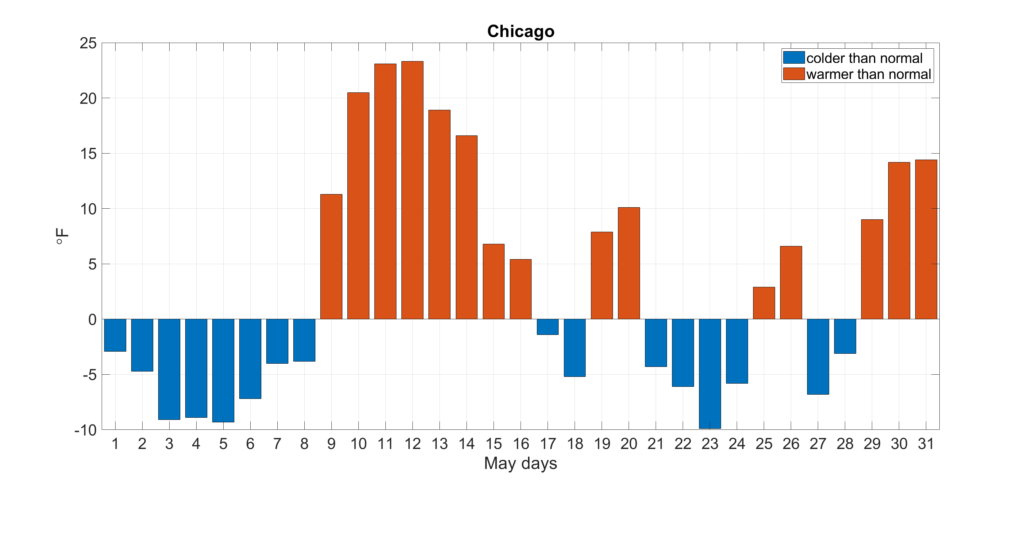
In fact, the week of May 9 to 15 was one of the warmest on record for May statewide, with temperatures persistently 8 to 20 degrees above normal (Figure 2). Rockford broke daily high daytime and daily high nighttime temperatures in four consecutive days that week, and both Rockford and Chicago recorded their earliest 70-degree nighttime low temperature on record. The heat was accompanied by summer-like humidity, and dewpoint temperatures regularly reached into the upper 60s and low 70s. Rockford reached its earliest 75-degree dewpoint temperature on record (back to 1959). Peoria recorded its earliest 73-degree nighttime low temperature on record (back to 1883), which beat the previous record by two weeks.
The heat itself was remarkable, but so was how quickly it arrived following prolonged cooler weather in April and in the first week of May. A rapid change from cool to hot weather, especially early in the warm season, is associated with an elevated risk of heat-related health impacts. At least three heat-related deaths were reported in Chicago the week of May 9.
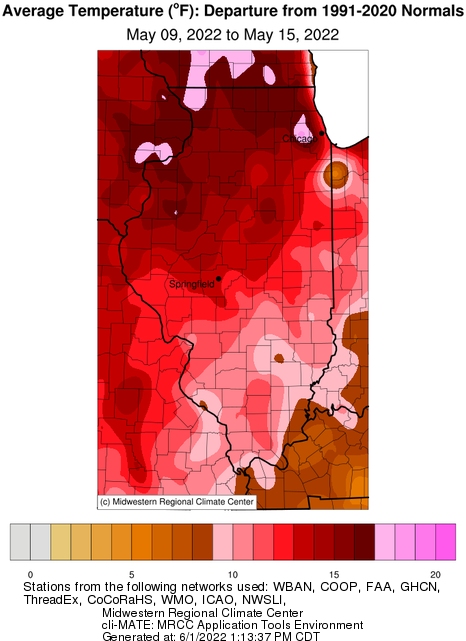
Thankfully, temperatures moderated in the third and fourth weeks of May. However, the month still ended with temperatures above normal across the state. May average temperatures ranged from the low 60s in northern Illinois to the high 60s in southern Illinois, between 1 and 5 degrees above normal (Figure 3). The hottest point in the state was Cairo with an average May temperature of 69.4 degrees, and the coldest part of the state was Waukegan with an average May temperature of 58.9 degrees.
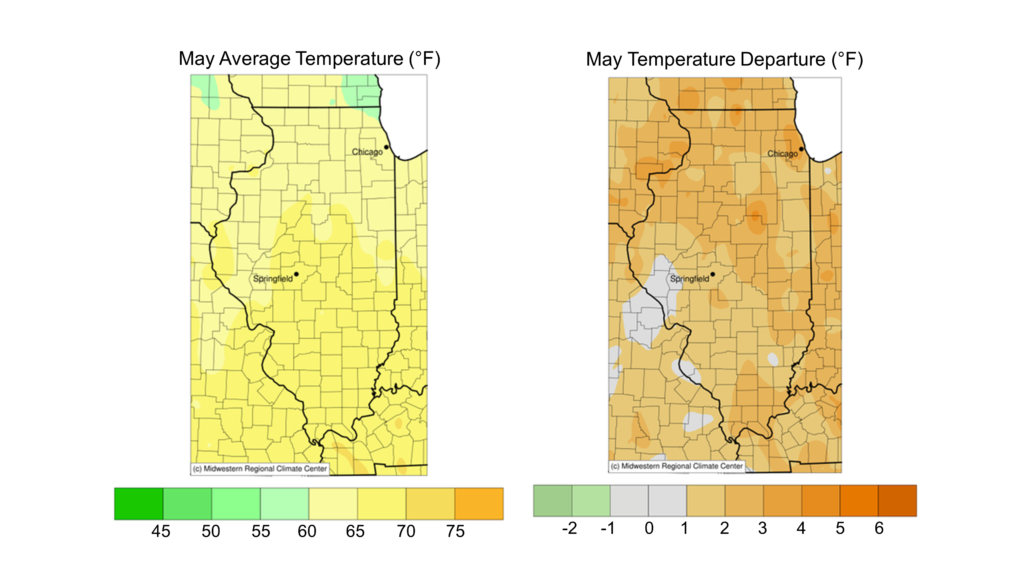
Altogether, daily high maximum temperature records were broken last month at 131 stations, and daily high minimum temperature records were broken at 125 stations. Three stations broke their all-time May high temperature records, including a 96-degree high on May 11 in Stockton in Jo Daviess County. Eight stations broke all-time May high nighttime temperature records, including a 74-degree low in Rockford on May 12.
Daily low maximum temperature records were broken last month at 17 stations, and daily low minimum temperature records were broken at 3 stations.
Overall, the preliminary statewide average May temperature was 64.7 degrees, 1.4 degrees above the 1991–2020 average and the 29th warmest on record going back to 1895.
It All Averages Out
March was 1 to 3 degrees warmer than normal, followed by a cold April with temperatures 2 to 6 degrees below normal, with May temperatures 2 to 6 degrees above normal (Figure 4). The result was a preliminary statewide climatological spring average temperature of 51.9 degrees, only 0.5 degrees below normal.
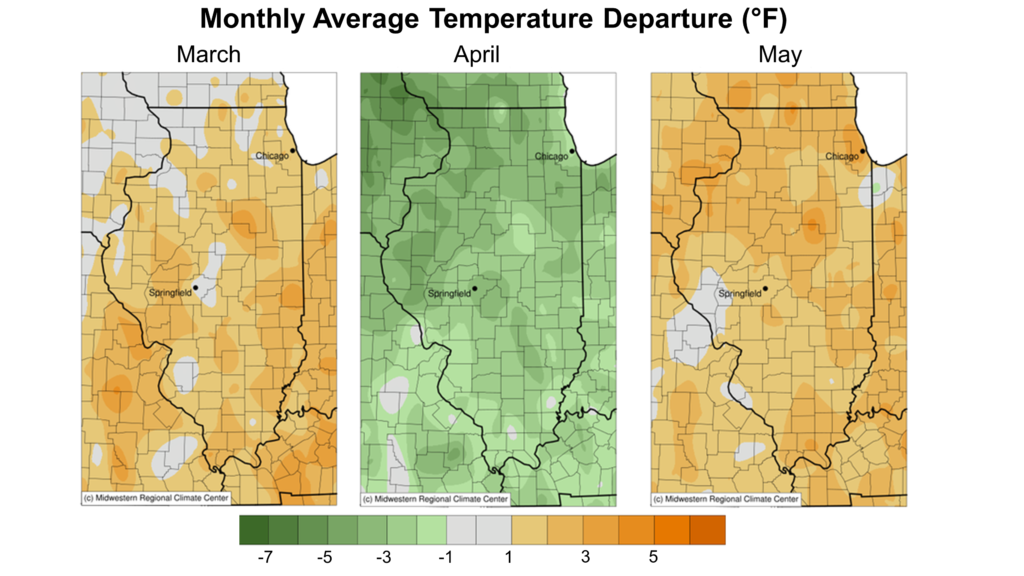
May Flowers, Sans Flooding and Drought
In recent years, May brought precipitation extremes of both types. May 2020 was the wettest on record in Chicago, while intense drought plagued most of northern Illinois in May 2021. This year, though, conditions in May were closer to normal.
Total precipitation last month ranged from just under 2 inches in southeast Illinois to over 7 inches on the north side of the St. Louis Metro East (Figure 5). The southwest and northeast corners of the state were 1 to 3 inches wetter than normal in May, while the northwest, southeast, and much of central Illinois were 1 to 3 inches drier than normal. The lack of widespread, heavy rain helped move spring fieldwork along very quickly following serious delays in April. Meanwhile, most parts of the state received enough rain to keep soil moisture adequate to surplus to stave off drought.
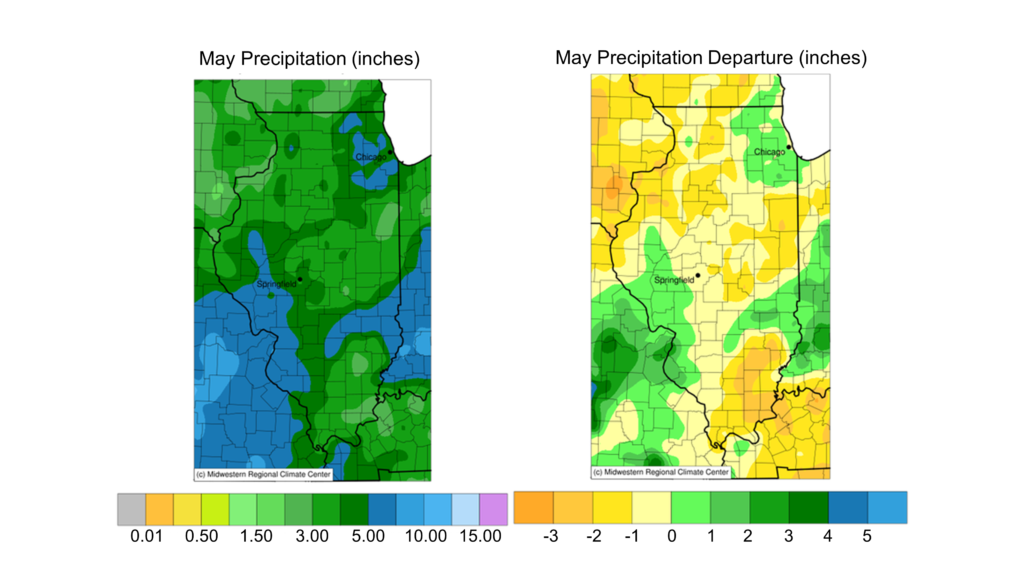
The wettest point in the state in May was Granite City in Madison County, with just under 8 inches of rain in total. In contrast, Fairfield in Wayne County received just 2.05 inches total in May. The preliminary statewide average total May precipitation was 4.37 inches, 0.40 inches below the 1991–2020 average and the 76th driest on record statewide.
Climatological spring precipitation was within 2 inches of normal through most of Illinois. Areas along the Mississippi River between Pike County and Monroe County, along with much of the Chicagoland area, were 2 to 6 inches wetter than normal in the spring, while parts of southeast Illinois were 2 to 4 inches drier than normal. The lack of an extremely wet spring helped minimize flooding in southern Illinois this spring, which is a good outcome given the relatively high flooding risk in the region coming out of winter this year. Meanwhile, three consecutive wetter than normal months have knocked out drought in northern Illinois. Parts of McHenry and Lake counties moved from severe drought in the U.S. Drought Monitor on March 1 to abnormally dry conditions (i.e., no drought) at the end of May.
Overall, the preliminary statewide total spring precipitation was 12.45 inches, 0.51 inches above normal.
June & Summer
June is the start of climatological summer and is on average the second wettest and third warmest month of the year in Illinois. The latest outlooks from the Climate Prediction Center lean toward a colder than normal start to summer, with equal chances of above and below normal precipitation in June (Figure 6).

Meanwhile, outlooks for the entire climatological summer, June–August, continue to lean toward warmer than normal conditions across the entire central U.S. This suggests the cooler start to the season may not last into July and August, although we’ll want to see how the models progress through June. Summer precipitation outlooks are also showing an equal chance of wetter and drier than normal conditions in Illinois, while drier than normal weather is expected farther west in Iowa, Nebraska, and Kansas (Figure 7).
